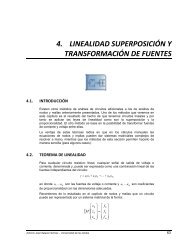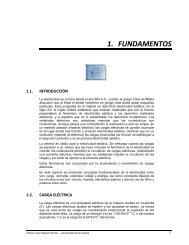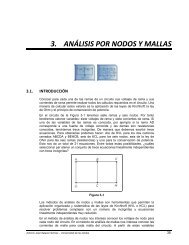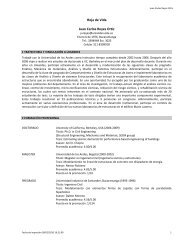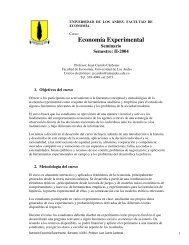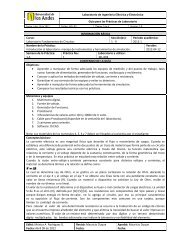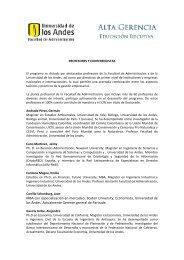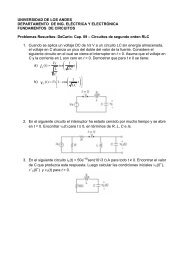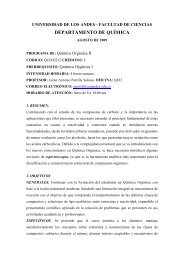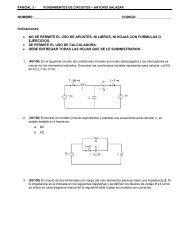understanding the relation between criticality and knowledge
understanding the relation between criticality and knowledge
understanding the relation between criticality and knowledge
Create successful ePaper yourself
Turn your PDF publications into a flip-book with our unique Google optimized e-Paper software.
UNDERSTANDING THE RELATION BETWEEN CRITICALITY ANDKNOWLEDGE IMPOSITION IN PEDAGOGYAndrés Mejía D.Departamento de Ingeniería IndustrialUniversidad de Los AndesCarrera 1 No.18A-10Bogotá, ColombiaE-mail: jmejia@uni<strong>and</strong>es.edu.coABSTRACTThe starting point is <strong>the</strong> idea that critical thinking can help promote intellectual autonomy <strong>and</strong> prevent<strong>the</strong> appearance of <strong>knowledge</strong> imposition. However, different critical approaches seem to do this indifferent ways, depending on <strong>the</strong>ir different conceptions of critique <strong>and</strong> critical thinking, <strong>and</strong> on <strong>the</strong>particular strategic choices <strong>the</strong>y make. An examination of <strong>the</strong>se conceptions <strong>and</strong> strategies shows that<strong>the</strong>y all fail to fully prevent <strong>knowledge</strong> imposition, but each for different reasons. In some cases, <strong>the</strong>approaches do not provide specific enough questioning tools, <strong>and</strong> <strong>the</strong>refore cannot guarantee that <strong>the</strong>irusers will actually be able to properly identify <strong>and</strong> question all <strong>the</strong> relevant aspects of forms of <strong>knowledge</strong>.In o<strong>the</strong>r cases <strong>the</strong> tools for questioning provided by <strong>the</strong> approaches implicitly dem<strong>and</strong> from students <strong>the</strong>acceptance of a form of <strong>knowledge</strong>, which <strong>the</strong>refore <strong>the</strong>y may end up accepting uncritically. A fur<strong>the</strong>rexamination of <strong>the</strong>se issues <strong>and</strong> <strong>the</strong> requirements <strong>the</strong>y impose on language shows that it will always beimpossible for any critical approach, or indeed any approach, to fully promote critical thinking <strong>and</strong>intellectual autonomy, <strong>and</strong> to prevent <strong>knowledge</strong> imposition. However, <strong>the</strong> framework used <strong>and</strong> providedhere at least allows one to identify, in particular cases, <strong>the</strong> dimensions in which intellectual autonomy <strong>and</strong>critical thinking are or are not being promoted.KEYWORDSintellectual autonomy, <strong>knowledge</strong> imposition, language, critical thinking, critical pedagogyINTRODUCTIONAn important connection can be established <strong>between</strong> <strong>criticality</strong> <strong>and</strong> <strong>knowledge</strong>imposition in education. Indeed, for instance, it has been thought that by promotingcritical thinking in <strong>the</strong>ir students, a teacher would at <strong>the</strong> same time be promotingintellectual autonomy <strong>and</strong> preventing <strong>knowledge</strong> imposition on <strong>the</strong>m. Critical thinkingwould allow students to question ideas, <strong>the</strong>ories, ideologies, social structures, processesof <strong>knowledge</strong> construction, etc., <strong>and</strong> <strong>the</strong>refore prevent <strong>the</strong>ir acceptance from beingimposed on <strong>the</strong>m. Or, perhaps, critique on forms of classroom communication mayallow a teacher to identify imposing elements in it, <strong>and</strong> redesign it so as to address thoseelements <strong>and</strong> allow for <strong>the</strong> emergence of intellectual autonomy in her/his students.1
However, many criticisms aimed at critical approaches in education <strong>and</strong> pedagogyindicate that many authors think that <strong>the</strong> attempts by <strong>the</strong> proponents of thoseapproaches have failed to fully prevent <strong>knowledge</strong> imposition. In some cases it haseven been claimed that <strong>the</strong>y even promote some form of <strong>knowledge</strong> imposition<strong>the</strong>mselves. In <strong>the</strong> light of <strong>the</strong>se criticisms, it is worth examining in some detail <strong>the</strong>existing <strong>relation</strong>s <strong>between</strong> pedagogical proposals about <strong>criticality</strong> <strong>and</strong> <strong>knowledge</strong>imposition. This paper has as its main purpose to explore those <strong>relation</strong>s, to see in whatdimensions, <strong>and</strong> to what extent, critical approaches in can or cannot help prevent<strong>knowledge</strong> imposition <strong>and</strong> promote intellectual autonomy in students.To this end, in section 1 I will present a very brief review of salient characteristics ofsome critical approaches, concentrating specially on those aspects that have most to dowith <strong>knowledge</strong> imposition. Section 2 will present a certain terminology that will beuseful for <strong>underst<strong>and</strong>ing</strong> <strong>the</strong> issues this paper is about. In section 3, I will formulatesome requirements established on <strong>the</strong> nature of language <strong>and</strong> <strong>knowledge</strong>, by <strong>the</strong>seapproaches, if <strong>the</strong>y are to effectively prevent imposition <strong>and</strong> promote autonomy. Insection 4, I will point at some issues concerning <strong>the</strong> discussion about whe<strong>the</strong>r thoserequirements can be met, <strong>and</strong> postulate <strong>the</strong> existence of an indissoluble dilemma thatmakes <strong>the</strong> full prevention of <strong>knowledge</strong> imposition an impossible. The final sectiondescribes some possible consequences for educational practice.1. CRITICAL APPROACHES IN PEDAGOGYSome critical approaches in pedagogy have been particularly influential, <strong>and</strong> I willbriefly present some of <strong>the</strong>ir characteristics here. My list may not be exhaustive, but itwill allow me to introduce <strong>the</strong> argument in <strong>the</strong> following sections.One critical approach in education is <strong>the</strong> one proposed by <strong>the</strong> Critical ThinkingMovement (see for instance Toulmin et al., 1984; Paul, 1993; <strong>and</strong> Ennis, 1995). It seeks todevelop philosophical <strong>the</strong>ories of argumentation, usually based on informal logic, <strong>and</strong>teach <strong>the</strong>m to students so that <strong>the</strong>y learn <strong>the</strong> skills <strong>and</strong> acquire <strong>the</strong> dispositions neededto assess arguments. In <strong>relation</strong> to <strong>knowledge</strong> imposition <strong>the</strong> idea is that if studentslearn <strong>the</strong>se <strong>the</strong>ories <strong>and</strong> use <strong>the</strong>m as tools, <strong>the</strong>y will <strong>the</strong>n question forms of <strong>knowledge</strong>that are presented to <strong>the</strong>m. Hence, <strong>the</strong>y will take responsibility for <strong>the</strong>ir acceptance orrejection. It is usually said that <strong>the</strong> <strong>the</strong>ories of argumentation or logic used by thismovement are not ideological.The main criticism found in <strong>relation</strong> to <strong>knowledge</strong> imposition consists in <strong>the</strong> lack ofpower of those tools for identifying <strong>and</strong> <strong>the</strong>refore questioning those aspects ofarguments that are not clearly visible, or are hidden, <strong>and</strong> that <strong>the</strong>refore do not form partof <strong>the</strong> “net of strict logical analysis” (Duhan Kaplan, 1991). This way, for instance, an2
impeccable logical analysis of some argument may fail to address important but nonexplicitissues in it.In <strong>the</strong> approach known as critical pedagogy students are also given tools for questioningforms of <strong>knowledge</strong> 1 , mainly <strong>the</strong> so-called dominant ones (see for instance Freire, 1970;Giroux, 1997; <strong>and</strong> McLaren, 1994). Freire’s notion of critical consciousness, for instance,defines a state of consciousness in which students are now able to properly questionboth reality <strong>and</strong> <strong>the</strong> presumably distorted views espoused by those in power. Those“dominant” views will <strong>the</strong>n not be imposed on students, as <strong>the</strong>y are not naïve anymore.There is, however, ano<strong>the</strong>r strategy in which <strong>the</strong>se authors seek to prevent <strong>knowledge</strong>imposition, <strong>and</strong> it is by organising <strong>the</strong> classroom interactions in such a way thatstudents are allowed to voice <strong>the</strong>ir views, <strong>and</strong> be listened by <strong>the</strong> o<strong>the</strong>r participants inconversation. In this way, <strong>the</strong> teacher will presumably not indoctrinate students intoher/his own ideology, but instead will help <strong>the</strong>m develop <strong>the</strong>ir own views. Freire’sdiscussions on dialogue <strong>and</strong> on banking education are manifestations of this.One strong criticism concerns <strong>the</strong> fact that <strong>the</strong> conscientisation process that allowsstudents to achieve critical consciousness is ideological in itself. For instance, inFreirean pedagogy critical consciousness is allegedly Marxist, although in o<strong>the</strong>r cases itmay take a different colour. This means that a Marxist view may be imposed onstudents, being <strong>the</strong> vehicle for this imposition <strong>the</strong> very process of empowering students(see for instance Burbules, 1993; <strong>and</strong> Buckingham, 1998).O<strong>the</strong>r authors in critical pedagogy have more recently tried to develop an approach thatdoes not commit to particular ideologies, <strong>the</strong>refore not dem<strong>and</strong>ing <strong>the</strong>ir adoption bystudents, <strong>and</strong> that will fur<strong>the</strong>rmore extend <strong>the</strong>ir critique to cover all, <strong>and</strong> not only one ortwo, forms of domination <strong>and</strong> oppression. Arguably <strong>the</strong>y see <strong>the</strong>mselves now asseeking to articulate silenced or repressed <strong>knowledge</strong>s, making <strong>the</strong>m publicly available,but at <strong>the</strong> same time critically questioning both <strong>the</strong>m <strong>and</strong> <strong>the</strong> dominant ones. However,<strong>the</strong> criticisms seem to not have been totally mitigated in comparison to early criticalpedagogy, as <strong>the</strong>re is apparently still <strong>the</strong> need for a positive vision of <strong>the</strong> future thatserves as a st<strong>and</strong>ard from which o<strong>the</strong>r views are seen <strong>and</strong> judged (see for instanceEllsworth, 1989; <strong>and</strong> Gur Ze’ev, 1998). And even if one limits oneself to <strong>the</strong> articulation<strong>and</strong> critique of dominant <strong>and</strong> alternative views, <strong>the</strong>n those articulation <strong>and</strong> critique<strong>the</strong>mselves may carry with <strong>the</strong>m <strong>the</strong> acceptance of a particular ideology or position.In post-radical pedagogies <strong>the</strong>re is a fur<strong>the</strong>r displacement of st<strong>and</strong>ards against whichparticular views or positions can be contrasted or judged. In fact, <strong>the</strong>re is no promotionof such st<strong>and</strong>ards, <strong>and</strong> <strong>the</strong> negative emancipatory interest that characterises criticalpedagogy is now replaced for <strong>the</strong> pure opening up of interpretive possibilities. The1 I will use <strong>the</strong> expression form of <strong>knowledge</strong> to refer to any idea, argument, belief, belief system, ideology, <strong>the</strong>ory,or worldview. I ask <strong>the</strong> reader to not give it any connotation of “true warranted belief”, for I do not intend to meanthat <strong>the</strong> truth of any belief can ever be established.3
preferred strategy consists in <strong>the</strong> continual articulation of fur<strong>the</strong>r textual possibilitieswhich remain hidden. The emphasis, however, is not put on <strong>the</strong> wider societal politicalissues that surround <strong>the</strong> classroom, but on <strong>the</strong> text. A problem that appears is onewhich was also present in critical pedagogy, but in a reduced way: By not pointing atspecific [political] issues, it is possible that <strong>the</strong>y will never come to <strong>the</strong> fore <strong>and</strong> bediscussed, <strong>and</strong> hence it is possible that <strong>the</strong> imposition of <strong>knowledge</strong> in that respect willnot be prevented. (In <strong>the</strong> case of critical pedagogy this criticism only referred to someparticular political issues that were left out of <strong>the</strong> analysis, as in <strong>the</strong> case of gender issuesin <strong>the</strong> Neo-Marxist approach espoused by Freire.) But, interestingly, what was just saidin <strong>the</strong> previous paragraph about recent versions of critical pedagogy can also apply topost-radical pedagogies: The very articulation of alternative <strong>knowledge</strong>s might be anexpression of <strong>the</strong> articulator’s ideological views.Nei<strong>the</strong>r of <strong>the</strong> two remaining approaches I will mention here, Young’s Habermasian one(Young, 1990 <strong>and</strong> 1992) <strong>and</strong> Gore’s Foucauldian one (Gore, 1995 <strong>and</strong> 1997), make anyuse of <strong>the</strong> strategy of giving tools to students, so that <strong>the</strong>y can question forms of<strong>knowledge</strong>. This time <strong>the</strong>y concentrate exclusively on <strong>the</strong> organisation of interactions.Gore is more pessimistic than Young as regards <strong>the</strong> possibility of creating a nonimposingtype of interactions, which is partly due to her adoption of Foucauldian formsof <strong>the</strong>orisation. In Young’s work, however, <strong>the</strong> ideal speech situation provides a kind ofbenchmark one can at least try to get closer to. Both of <strong>the</strong>m attempt, using varioustools, to characterise real conversations in terms of various ideal descriptions ofinteractions that are regarded as symmetrical/ asymmetrical, repressive/ nonrepressive,etc. In this case, <strong>and</strong> assuming that <strong>the</strong>ir analyses are to a large extentcorrect, <strong>the</strong>re would still be something missing from <strong>the</strong> picture of <strong>knowledge</strong>imposition: As <strong>the</strong>y do not deal with contents, <strong>the</strong>y do not teach how to identify <strong>and</strong>question forms of <strong>knowledge</strong>, <strong>and</strong> <strong>the</strong>refore some of <strong>the</strong>se may remain hidden <strong>and</strong> beinvisibly imposed. Maddock, for instance, has in fact argued that Young’s approachcannot help students articulate <strong>and</strong> address <strong>the</strong> political <strong>and</strong> existential issues of <strong>the</strong>irlives (1999).2. A GENERAL CHARACTERISATION OF CRITICAL APPROACHESI will now attempt to characterise <strong>the</strong> approaches mentioned above in terms of a set ofaspects useful for <strong>underst<strong>and</strong>ing</strong> <strong>the</strong> <strong>knowledge</strong> dimensions along which <strong>the</strong>y promoteor prevent <strong>the</strong> appearance of critical thinking <strong>and</strong> intellectual autonomy.I will start by distinguishing <strong>between</strong> different types of forms of <strong>knowledge</strong> play a partin <strong>the</strong> act of critical thinking, <strong>and</strong> in <strong>the</strong> critical thinking classroom. On <strong>the</strong> one h<strong>and</strong>,<strong>the</strong>re is <strong>knowledge</strong> coming from sources usually external to <strong>the</strong> classroom (<strong>the</strong> media,<strong>the</strong> government, tradition, etc.), but sometimes also internal to it (textbooks, o<strong>the</strong>r4
students, etc.), that critical approaches may help students be critical about. Just to putan example, in some context it may be <strong>the</strong> ideas embedded in culture about <strong>the</strong> role ofwomen in society. Let me call <strong>the</strong>se forms of <strong>knowledge</strong>, target forms of <strong>knowledge</strong>.But <strong>the</strong>re are also <strong>the</strong> various forms of ra<strong>the</strong>r <strong>the</strong>oretical <strong>knowledge</strong>, provided by <strong>the</strong>critical approaches, that are used by <strong>the</strong> teacher in some way in order to help studentsbecome critical. I will refer to <strong>the</strong>m as <strong>the</strong>ories of <strong>the</strong> critical. For instance, in <strong>the</strong> caseof <strong>the</strong> critical thinking movement, <strong>the</strong> <strong>the</strong>ories of <strong>the</strong> critical used are normally <strong>the</strong>oriesof argumentation <strong>and</strong> informal logic. For critical pedagogy <strong>the</strong>y are normally semiotic,sociological <strong>and</strong> epistemological <strong>the</strong>ories. And lastly, <strong>the</strong>re are forms of <strong>knowledge</strong>represented in <strong>the</strong> beliefs held by <strong>the</strong> proponents of <strong>the</strong> critical approaches, <strong>and</strong>/or by<strong>the</strong> teachers attempting to help <strong>the</strong>ir students be critical, about <strong>the</strong> same domain that <strong>the</strong>target forms of <strong>knowledge</strong> are about. I will term <strong>the</strong>m source forms of <strong>knowledge</strong>. Tocontinue with <strong>the</strong> example above, in that case <strong>the</strong> role of source form of <strong>knowledge</strong> willbe played by <strong>the</strong> ideas held by <strong>the</strong> teacher, <strong>and</strong>/or by <strong>the</strong> proponents of <strong>the</strong> criticalapproach being used by him/her, about <strong>the</strong> role of women in society.The criticisms made to each of <strong>the</strong> critical approaches, briefly mentioned in <strong>the</strong> previoussection, can now be understood as being (1) ei<strong>the</strong>r about <strong>the</strong> approach’s inability to helpstudents properly identify <strong>and</strong> question all possible relevant target forms of <strong>knowledge</strong>or all possible relevant aspects of <strong>the</strong> chosen target forms of <strong>knowledge</strong>, or (2) about <strong>the</strong>approach’s tendency to impose its source forms of <strong>knowledge</strong> on students. In thissecond case, interestingly, imposition of a certain view will have occurred in <strong>the</strong> name ofcritique.The first of <strong>the</strong>se types of criticism applies to what has been said about <strong>the</strong> <strong>the</strong>ories ofargumentation used by <strong>the</strong> critical thinking movement <strong>and</strong> about <strong>the</strong> Habermasianapproach developed by Robert Young. The second type of criticism has beenparticularly predominant in <strong>the</strong> literature about critical pedagogy. In this case <strong>the</strong><strong>the</strong>ory of <strong>the</strong> critical used seems to carry with it, or entail, a particular source form of<strong>knowledge</strong> which ends up being imposed. However, it may also happen that even if <strong>the</strong><strong>the</strong>ory of <strong>the</strong> critical does not directly imply a source form of <strong>knowledge</strong>, <strong>the</strong>n one suchform of <strong>knowledge</strong> may make itself present in <strong>the</strong> act of critical thinking, or of beingcritical about <strong>the</strong> target form of <strong>knowledge</strong>. For instance, students may end up using<strong>the</strong> <strong>the</strong>ories of <strong>the</strong> critical learned, simply to legitimise <strong>the</strong>ir own previous positions <strong>and</strong>win debates, without subjecting <strong>the</strong>ir own views to critical scrutiny.Let me now postulate, in <strong>the</strong> manner of some kind of ideal types, some possibilities inwhich <strong>the</strong> three different kinds of <strong>knowledge</strong> involved in <strong>the</strong> act of critical thinking(source, target, <strong>and</strong> <strong>the</strong>ories of <strong>the</strong> critical) can be related. One of <strong>the</strong>m happens when<strong>the</strong> <strong>the</strong>ory of <strong>the</strong> critical does not talk about, or entail, any sort of content, <strong>and</strong> remainsat a purely pedagogical level concerning only formal interactions <strong>between</strong> persons (e.g.,teacher <strong>and</strong> students in <strong>the</strong> classroom). Of <strong>the</strong>m I will say that <strong>the</strong>y use pedagogical5
<strong>the</strong>ories of <strong>the</strong> critical. To a great extent this is <strong>the</strong> case of Young’s Habermasian <strong>and</strong>Gore’s Foucauldian approaches.Ano<strong>the</strong>r possibility is that <strong>the</strong> <strong>the</strong>ories of <strong>the</strong> critical do talk about contents, or aboutways of dealing critically with contents, but in a way in which <strong>the</strong>re is no direct <strong>relation</strong>to any source form of <strong>knowledge</strong> in particular. I will call <strong>the</strong>m, content-empty <strong>the</strong>oriesof <strong>the</strong> critical. Again, to a great extent this is <strong>the</strong> case of <strong>the</strong> <strong>the</strong>ories of argumentation<strong>and</strong> informal logic used by <strong>the</strong> critical thinking movement.Lastly, <strong>the</strong>re is <strong>the</strong> possibility that <strong>the</strong> <strong>the</strong>ory of <strong>the</strong> critical used does talk about contentsin a very concrete <strong>and</strong> explicit way, even describing explicitly in advance <strong>the</strong> variousdifferent possible target readings of reality. These are, in my terminology, content-full<strong>the</strong>ories of <strong>the</strong> critical. In a way, it can be said that whereas content-empty <strong>the</strong>ories of<strong>the</strong> critical only provide <strong>the</strong> questions one should ask about a target form of <strong>knowledge</strong>,content-full <strong>the</strong>ories of <strong>the</strong> critical provide both <strong>the</strong> questions <strong>and</strong> <strong>the</strong> different possibleanswers to <strong>the</strong>m for every possible source or target form of <strong>knowledge</strong>. Now, in somecases <strong>the</strong> <strong>the</strong>ory of <strong>the</strong> critical will be directly tied to one particular source form of<strong>knowledge</strong> that is taken to be true, or valid. In this case I will say that it is anadvocating content-full <strong>the</strong>ory of <strong>the</strong> critical. However, if <strong>the</strong> <strong>the</strong>ory of <strong>the</strong> criticalsimply presents a range of possibilities without declaring any one of <strong>the</strong>m valid or true,it can be called a non-advocating content-full <strong>the</strong>ory of <strong>the</strong> critical. The following tableprovides a summary of <strong>the</strong> categories, <strong>and</strong> also names some critical approaches ineducation that can more or less be suited to a particular category:Approaches that deal with contentsApproaches that dealwith pedagogicalinteractionsContent-full Content-empty (Content-empty)Advocating Non-advocating (Non-advocating) (Non-advocating)Freire’s approach,critical pedagogyCritical pedagogy,post-radicalpedagogiesCritical thinkingmovement, criticalpedagogyYoung’s, Gore’s, <strong>and</strong>Freire’s approachesNow, <strong>the</strong> idea of content-full <strong>and</strong> content-empty <strong>the</strong>ories of <strong>the</strong> critical can also be seen,according to this table, as something that specifies a gradualism from left to right. Themore one goes to <strong>the</strong> right of <strong>the</strong> table, <strong>the</strong> less content is entailed by <strong>the</strong> <strong>the</strong>ory of <strong>the</strong>critical; that is, <strong>the</strong> less beliefs about content one has to accept in order to apply it. Thecategories may be taken as simply pointing at extremes in a gradual scale.The reader may also notice that some approaches appear more than once. Let meexplain: In <strong>the</strong> case of Freire’s approach, it provides both a content-full advocating6
<strong>the</strong>ory of <strong>the</strong> critical, <strong>and</strong> a pedagogical one, in a ra<strong>the</strong>r separate way 2 . Criticalpedagogy (in o<strong>the</strong>r non-Freirean forms) appears three times, but this time because of <strong>the</strong>ambiguity present in <strong>the</strong> literature found, <strong>and</strong> <strong>the</strong> subsequent difficulty in <strong>the</strong>classification. Arguably, sometimes only a general abstract <strong>the</strong>ory —withcorresponding general abstract critical questions— is presented, <strong>and</strong> it is up to <strong>the</strong>reader to bring it down to her/his subjects of concern. In some o<strong>the</strong>r cases, <strong>the</strong> <strong>the</strong>ory ispresented toge<strong>the</strong>r with more concrete indications for critique in particular cases,explaining <strong>the</strong> possible answers to <strong>the</strong> critical questions for various different forms of<strong>knowledge</strong> —or <strong>knowledge</strong>s— but stating explicitly that none is being advocated.However, sometimes a particular form of <strong>knowledge</strong> is advocated, even explicitly.Never<strong>the</strong>less, I take it that this variety <strong>and</strong> ambiguity does not constitute a reason fordismissing <strong>the</strong> categories here proposed as irrelevant, <strong>and</strong> instead think that <strong>the</strong>categories help one underst<strong>and</strong> in a better way <strong>the</strong> variety in <strong>the</strong> critical pedagogyliterature.3. SOME REQUIREMENTS FOR CRITICAL APPROACHES TO BE ABLE TO FULLYAND EFFECTIVELY PROMOTE CRITICAL THINKINGIn this section I will try to establish <strong>the</strong> requirements imposed on <strong>the</strong> nature of language<strong>and</strong> <strong>knowledge</strong>, by each of <strong>the</strong> various kinds of <strong>the</strong>ories of <strong>the</strong> critical described in <strong>the</strong>previous section.3.1 PEDAGOGICAL THEORIES OF THE CRITICALApproaches using exclusively pedagogical <strong>the</strong>ories of <strong>the</strong> critical face variousdifficulties if <strong>the</strong>y are willing to promote critical thinking <strong>and</strong> prevent <strong>the</strong> imposition of<strong>knowledge</strong>. The main salient characteristic consists in <strong>the</strong> fact that <strong>the</strong>y do not deal withcontents. This means that whatever contents are brought into <strong>the</strong> classroomconversation are brought by <strong>the</strong> classroom participants (i.e., <strong>the</strong> teacher, <strong>the</strong> students,<strong>the</strong> texts, etc.) without any help from <strong>the</strong> approach. This effectively means that only thoseforms of <strong>knowledge</strong> <strong>and</strong> aspects of <strong>the</strong>m that happen to occur to <strong>the</strong>m will beaddressed.What, <strong>the</strong>n, would be necessary in order for such an approach to be good enough for <strong>the</strong>development of critical thinking in students? It seems to me that <strong>the</strong> contents that arerelevant for critical questioning have to be in some way given, so that <strong>the</strong>refore it issimply not necessary that <strong>the</strong> critical approach brings it to <strong>the</strong> fore, for <strong>the</strong>y willeventually come out anyway. The assumption seems to be that <strong>the</strong> participants inclassroom conversation have all <strong>the</strong> <strong>knowledge</strong> resources needed for critical2 It is actually my contention that this creates an unavoidable tension. This idea has been developed elsewhere(Mejía, forthcoming).7
questioning, <strong>and</strong> that all that is necessary is that <strong>the</strong>y be allowed to work in a properinquiry context. Let me now call this requirement, givenness.3.2 CONTENT-EMPTY THEORIES OF THE CRITICALI have already explained that content-empty <strong>the</strong>ories of <strong>the</strong> critical provide some <strong>the</strong>orybackedquestions that <strong>the</strong> critical person should ask of any target form of <strong>knowledge</strong>,but without being too explicit about how in each particular case <strong>the</strong>y should beanswered. The central point to emphasise here is <strong>the</strong> fact that it may still be polemic, orproblematic, how each person using <strong>the</strong> <strong>the</strong>ory of <strong>the</strong> critical will produce an appraisalor assessment of particular target forms of <strong>knowledge</strong>.In comparison with pedagogical <strong>the</strong>ories of <strong>the</strong> critical, <strong>the</strong> contents brought into <strong>the</strong>conversation are not this time left so open, because at least it is guaranteed that certaintopics will be explored. There is, however, still some degree of givenness that isrequired for <strong>the</strong>se approaches to be able to guarantee that critical thinking will be fullydeveloped in students, in that whatever is left open cannot be guaranteed. If <strong>the</strong>re is nogivenness, <strong>the</strong>n students might still be unable to properly identify <strong>and</strong> <strong>the</strong>n questionrelevant forms of <strong>knowledge</strong> <strong>and</strong> relevant aspects of <strong>the</strong>m that simply do not occur to<strong>the</strong>m. The emptier <strong>the</strong> <strong>the</strong>ory, <strong>the</strong> greater <strong>the</strong> degree of givenness that it requires.3.3 CONTENT-FULL THEORIES OF THE CRITICALIf it is <strong>the</strong> case that both pedagogical <strong>and</strong> content-empty <strong>the</strong>ories of <strong>the</strong> critical requiresome degree of givenness in order to be able to fully prevent <strong>knowledge</strong> imposition <strong>and</strong>promote critical thinking, <strong>the</strong>n content-full ones, because <strong>the</strong>y do provide contents, donot impose such requirement.But, of course, being on <strong>the</strong> o<strong>the</strong>r side of <strong>the</strong> equation implies certain o<strong>the</strong>r things.Firstly, advocating content-full <strong>the</strong>ories of <strong>the</strong> critical are tied to a particular source formof <strong>knowledge</strong> which is taken to be true or valid. This means that students, in order to becritical in <strong>the</strong> way envisaged by <strong>the</strong> approach, have to come to accept that source formof <strong>knowledge</strong>. Now, that acceptance might come about in <strong>the</strong> form of an imposition on<strong>the</strong> students, using whatever manipulative means one wants; but that would mean thatwhile one is promoting critical thinking about o<strong>the</strong>r people’s ideas <strong>and</strong> forms of<strong>knowledge</strong>, one is also preventing students from being critical about one’s advocatedform of <strong>knowledge</strong>. Alternatively, one might try to provide <strong>the</strong> context for a rationalinquiry, <strong>and</strong> simply hope that students will, on <strong>the</strong>ir own (whatever that means),rationally come to accept <strong>the</strong> required source form of <strong>knowledge</strong>. For this secondoption to work, <strong>the</strong>re is <strong>the</strong>n a requirement that I can now formulate, which is that <strong>the</strong>advocated source form of <strong>knowledge</strong> be rationally inescapable. For that reason I havecalled <strong>the</strong> requirement, inescapability.8
If one does not want to rely on <strong>the</strong> inescapability of a source reading of reality, or on <strong>the</strong>givenness of <strong>the</strong> relevant aspects that need to be questioned of target forms of<strong>knowledge</strong>, <strong>the</strong>n one might want to have a non-advocating content-full <strong>the</strong>ory of <strong>the</strong>critical. Its simplest manifestation may be present in what many teachers frequentlyclaim to do: “I don’t teach <strong>the</strong>m my view, but instead give <strong>the</strong>m <strong>the</strong> set of alternativepossibilities, for <strong>the</strong>m to decide on <strong>the</strong>ir own which one <strong>the</strong>y’ll take.” This option seemsto be a very good one indeed, <strong>and</strong> I think it goes in <strong>the</strong> right direction; but I also take itthat it should be examined carefully before any conclusion is reached. Let us notice thatin this case it is not a source reading of reality which might be imposed on students —asin <strong>the</strong> case of advocating content-full <strong>the</strong>ories of <strong>the</strong> critical— but an interpretation (<strong>the</strong>teacher’s) of a set of target forms of <strong>knowledge</strong>. If <strong>the</strong> interpretation carries <strong>the</strong> sign of<strong>the</strong> teacher’s source form of <strong>knowledge</strong>, <strong>and</strong> is not independent from it, <strong>the</strong>n in one wayor ano<strong>the</strong>r it may end up being imposed on students, in a much subtler <strong>and</strong> invisibleway. I have called this requirement, interpretation independence, alluding to <strong>the</strong>independence required <strong>between</strong> <strong>the</strong> teacher’s views on a topic, <strong>and</strong> her/hisinterpretation of <strong>the</strong> set of alternative views on <strong>the</strong> same topic.4. ON THE IMPOSSIBILITY OF FULFILLING THE REQUIREMENTSThe space is very limited here to fully address <strong>the</strong> question of whe<strong>the</strong>r each of <strong>the</strong>serequirements can be fulfilled. However, I will attempt to describe some aspects that areinvolved in this problem <strong>and</strong> direct <strong>the</strong> reader to o<strong>the</strong>r texts that have explored some of<strong>the</strong>m. This will, I hope, also show why my answer to <strong>the</strong> question is that <strong>the</strong>requirements cannot be fulfilled.4.1 GIVENNESSThe discussion about <strong>the</strong> requirement of givenness is similar in some sense to <strong>the</strong>discussion about <strong>the</strong> requirement of inescapability that I will present in section 4.2.Givenness, in its most extreme form, depends on <strong>the</strong> fact that given <strong>the</strong> rightconversational conditions of inquiry, no relevant aspects of a target form of <strong>knowledge</strong>will pass without being identified <strong>and</strong> questioned. In less extreme forms, it depends on<strong>the</strong> fact that given some general critical questions or categories, anyone will be able toidentify <strong>and</strong> question all <strong>the</strong> relevant aspects about a target form of <strong>knowledge</strong>.The problem with this is that <strong>the</strong>re are no aspects in reality that anyone inevitablywould identify when in a “face-to-face situation with reality” (see Sellars, 1956; <strong>and</strong>Rorty, 1979). As <strong>the</strong> work of authors like Davidson (1984) <strong>and</strong> Sellars (1956) shows,reality is not divided into separate facts, <strong>and</strong> facts can only be separated <strong>and</strong>distinguished in our sentences in language. If one fur<strong>the</strong>r accepts <strong>the</strong> doctrine of <strong>the</strong>9
holism of language, as advocated by Quine, Rorty, Davidson, <strong>and</strong> o<strong>the</strong>rs, <strong>the</strong>n one’s actof distinguishing any aspect [of reality, whatever that means], depends on one’s beliefsystem. And <strong>the</strong>n, different belief systems will take different people to distinguish <strong>and</strong>take as meaningful <strong>and</strong> relevant, different aspects.If <strong>the</strong> above argument is correct, <strong>the</strong>n a <strong>the</strong>ory of <strong>the</strong> critical using a pedagogical orcontent-empty <strong>the</strong>ory of <strong>the</strong> critical cannot guarantee that all relevant aspects of a targetform of <strong>knowledge</strong> will actually be identified <strong>and</strong> questioned by <strong>the</strong> students.4.2 INESCAPABILITYThe search for inescapability of forms of <strong>knowledge</strong> corresponds to <strong>the</strong> search for somekind of epistemological source of certainty; that is, <strong>the</strong> search for something that willguarantee that some beliefs are compelling <strong>and</strong> incorrigible. The discussion around thistopic has been tremendously extensive in <strong>the</strong> history of philosophy, <strong>and</strong> it is certainlynot within <strong>the</strong> scope of this paper to recreate <strong>the</strong> arguments <strong>and</strong> positions involved. Iwill simply state that in this matter I follow <strong>the</strong> positions of Rorty <strong>and</strong> Davidson, <strong>and</strong>with <strong>the</strong>m claim that nothing can play <strong>the</strong> role of an epistemological source of certainty.The of this consequences for <strong>the</strong> present argument can be summarised in that, strictlyspeaking, no source form of <strong>knowledge</strong> can be taken as inescapable, <strong>and</strong> <strong>the</strong>refore anyapproach using an advocating content-full <strong>the</strong>ory of <strong>the</strong> critical will tend to impose<strong>knowledge</strong>.This position is a philosophical one, of course, <strong>and</strong> one can wonder if it may be lessextreme to grant that in all sorts of conversations outside of <strong>the</strong> realm of philosophy oneis at least relatively justified in having some certainty about certain issues. I woulddefinitely agree with such a position; however, how far does it go? In most cases inpractice, out of <strong>the</strong> abstractions of philosophy, reasoning <strong>and</strong> argumentation seem toadvance from, let me call <strong>the</strong>m that way, basic ideas to non-basic ideas 3 . Basic ideaswould have at least two characteristics: The speaker has some certainty about <strong>the</strong>m, <strong>and</strong>s/he thinks that her/his audience share a similar degree of certainty about <strong>the</strong>m. Now,critical thinking cannot be about <strong>the</strong> obvious, or about <strong>the</strong> clearly visible, <strong>and</strong> cannotlimit itself to restate basic ideas. It necessarily has to advance to non-basic ones, but<strong>the</strong>n it is here where polemics <strong>and</strong> argumentation risks appear. Critical thinking cannotbut develop in <strong>the</strong> realm of <strong>the</strong> problematic, <strong>the</strong> polemic, <strong>and</strong> <strong>the</strong> difficult. Given this,inescapability in practice does not look much better than in <strong>the</strong> strictness of purephilosophy.4.3 INTERPRETATION INDEPENDENCE3 In some sense this idea can be seen as derived from Toulmin’s discussion on arguments (1958).10
I have talked about interpretation of some form of <strong>knowledge</strong> as <strong>the</strong> way in whichsomeone underst<strong>and</strong>s it. It is common to take <strong>the</strong> <strong>underst<strong>and</strong>ing</strong> of a form of<strong>knowledge</strong> as an act that can be separated from o<strong>the</strong>r <strong>knowledge</strong>-related acts such asassessing or evaluating that form of <strong>knowledge</strong>, critical thinking about it, <strong>and</strong> so on. Awise saying advises us to first underst<strong>and</strong> <strong>and</strong> only <strong>the</strong>n criticise. A related idea is that<strong>the</strong>re is something called <strong>the</strong> meaning of a word or sentence, that one grasps, <strong>and</strong> that isdifferent from, but basis for, later analyses.I have argued elsewhere (Mejía, 2001), based on <strong>the</strong> philosophy of Quine <strong>and</strong> Davidson,that <strong>the</strong> interpretation of a speaker’s sentences necessarily implies an active interpreterwho uses her/his own beliefs about <strong>the</strong> same topic <strong>the</strong> speaker is talking about. In thisview <strong>the</strong> interpreter translates <strong>the</strong> speaker’s sentences into some sentences s/he knowshow to use. Knowing how to use a sentence , in turn, is to know [many] relatedsentences <strong>and</strong> how <strong>the</strong>y relate to it, as well as possible appropriate or inappropriatecontexts of use. In interpretation, <strong>the</strong>n, are implied those related sentences <strong>and</strong> possiblecontexts of use; however, <strong>the</strong>re is no single finite set of related sentences, which isnecessary <strong>and</strong> sufficient for grasping <strong>the</strong> meaning of <strong>the</strong> sentences to be interpreted.This is just a consequence of rejecting <strong>the</strong> analytic-syn<strong>the</strong>tic distinction (Quine, 1953)<strong>and</strong> of accepting <strong>the</strong> holism of meaning <strong>and</strong> <strong>knowledge</strong> (Davidson, 1984). An importantpoint to emphasise is that <strong>the</strong> related sentences that appear in interpretation depend on<strong>the</strong> interpreter’s belief system, <strong>and</strong> <strong>the</strong>refore may vary from one person to ano<strong>the</strong>r.Interpretation, strictly speaking, is never exactly <strong>the</strong> same.As in <strong>the</strong> case of inescapability looked at in <strong>the</strong> previous section, one may wonder if<strong>the</strong>re is a sufficiently large basis of agreement in belief systems so that differentinterpreters’ interpretations will usually coincide. Of course, we all must surely sharelots of beliefs, as that is what allows <strong>underst<strong>and</strong>ing</strong> to occur. And lots of aspects of ourinterpretations will match very well. But again, one cannot take critical thinking to lie inissues about which <strong>the</strong>re is generalised agreement, for <strong>the</strong> minimum one expects fromcritical thinking <strong>and</strong> <strong>the</strong> critical person is to go beyond <strong>the</strong> common <strong>and</strong> obvious.Critical thinking about some target form of <strong>knowledge</strong> is constituted by criticalinterpretations of it, in which connections with new dimensions beyond <strong>the</strong> obvious aremade (Duhan Kaplan, 1994), in related sentences.An indication that interpretation independence cannot be is apparent in everyday life:“This is what <strong>the</strong>y think: …” sentences very usually have a much worse appearance than“this is what we think: …” sentences, as can be seen very frequently in politics <strong>and</strong>academic conferences. A fur<strong>the</strong>r implication is that <strong>the</strong> line separatingmis<strong>underst<strong>and</strong>ing</strong>s <strong>and</strong> disagreements, except in ra<strong>the</strong>r trivial cases, is very fuzzy.11
5. CONCLUDING REMARKSIf my arguments are correct, <strong>the</strong>n <strong>the</strong>re is no possible way in which an approach canever comprehensivelly promote critical thinking, <strong>and</strong> prevent all sorts of <strong>knowledge</strong>imposition. Critical thinking occurs in particular situations, about particular topics, <strong>and</strong>about particular ideas within a topic. A person may have developed a critical attitude,<strong>and</strong> that surely helps her/him be critical <strong>and</strong> take responsibility for her/his acceptedbeliefs in many cases; but that does not guarantee that s/he will be able to do so in everypossible or even every relevant occasion. S/he will simply not have <strong>the</strong> <strong>knowledge</strong>resources necessary for doing so.The reasons given in this paper for that impossibility can be related to <strong>the</strong> nature oflanguage. About any possible target form of <strong>knowledge</strong>, if someone (e.g. a student) isleft on her/his own to assess it <strong>and</strong> decide if s/he will accept it or not, <strong>the</strong>n it is possiblethat s/he will not recognise various relevant aspects that s/he should take into accountin that assessment. In my terminology, those aspects are not given. But on <strong>the</strong> o<strong>the</strong>rh<strong>and</strong>, if someone else (e.g. a teacher) shows her/him some aspects to question orexamine about <strong>the</strong> target form of <strong>knowledge</strong>, <strong>the</strong>n her/his acceptance of <strong>the</strong> relevance<strong>and</strong> meaningfulness of those aspects will imply <strong>the</strong> acceptance of a whole set ofadditional beliefs, which <strong>the</strong>n can be imposed. Again, in my terminology, those aspectsare not inescapable, <strong>and</strong> <strong>the</strong>y are part of an interpretation that is not independent from<strong>the</strong> interpreter’s beliefs about what <strong>the</strong> target form of knowlefge is about. Questioningalways takes place from belief systems, <strong>and</strong> is never devoid of belief commitments.Fur<strong>the</strong>rmore, <strong>the</strong> more content-full <strong>the</strong> <strong>the</strong>ory of <strong>the</strong> critical used is, <strong>the</strong> more <strong>the</strong> criticalthinking work is done by <strong>the</strong> <strong>the</strong>orist, <strong>and</strong> less by <strong>the</strong> student who is supposed to becritical. But if one wants it <strong>the</strong> o<strong>the</strong>r way, if one decides to place full trust on <strong>the</strong>students, <strong>the</strong>n ano<strong>the</strong>r <strong>relation</strong> applies: The less <strong>the</strong> <strong>the</strong>ory of <strong>the</strong> critical specifies, <strong>the</strong>more <strong>the</strong> critical thinking work is done by <strong>the</strong> students, but also <strong>the</strong> less <strong>the</strong> teacher isable to guarantee that <strong>the</strong>y will actually get to critically identify <strong>and</strong> question relevantforms of <strong>knowledge</strong> <strong>and</strong> relevant aspects of <strong>the</strong>m.Now, if <strong>the</strong>re is no way in which <strong>knowledge</strong> imposition from all sources can be avoided,<strong>the</strong>n <strong>the</strong> teacher should perhaps see her/himself as needing to make choices about whataspects of <strong>knowledge</strong> <strong>and</strong> of <strong>the</strong> students’ lives are better questioned than not, <strong>and</strong> whato<strong>the</strong>rs s/he will simply not attempt to address; <strong>and</strong> about what aspects s/he willcommit to convince her/his students even if that implies some form of imposition. Thechoices are inevitable, because every interaction or lack of it carries some form ofimposition, <strong>and</strong> because no epistemology can tell us how to proceed. Critical thinking isnot about some specific kind of connections that <strong>the</strong> critical person makes about anytarget form of <strong>knowledge</strong>, be <strong>the</strong>m political, epistemological, or of whatever nature. It issimply about making connections, without any restrictions. Which connections one willconcentrate on is a choice one has to make, but for reasons outside of <strong>the</strong> nature of12
critical thinking <strong>and</strong> critique. That choice involves necessarily but not exclusivelyethical considerations; <strong>and</strong> education is fundamentally an enterprise submerged inethics.REFERENCESBuckingham, D. (1998). Introduction: Fantasies of Empowerment? Radical Pedagogy <strong>and</strong> PopularCulture. In D. Buckingham (ed.), Teaching Popular Culture Beyond Radical Pedagogy. UCL,London, 1-17.Burbules, N. (1993). Dialogue in Teaching: Theory <strong>and</strong> Practice. Teachers College, New York.Davidson, D. (1984). Inquiries into Truth <strong>and</strong> Interpretation. Clarendon, Oxford.Duhan Kaplan, L. (1991). Teaching Intellectual Autonomy: The Failure of <strong>the</strong> Critical ThinkingMovement. In K. Walters (ed.), Re-Thinking Reason: New Perspectives in Critical Thinking. StateUniversity of New York, Albany, 205-219, 1994.Ellsworth, E. (1989). Why Doesn't This Feel Empowering? Working Through <strong>the</strong> Repressive Myths ofCritical Pedagogy. In Harvard Educational Review, vol.59, no.3, 297-324.Ennis, R. (1995). Critical Thinking. Prentice Hall, Upper Saddle River.Freire, P. (1970). Pedagogy of <strong>the</strong> Oppressed. Seabury, New York.Giroux, H. (1997). Pedagogy <strong>and</strong> <strong>the</strong> Politics of Hope: Theory, Culture, <strong>and</strong> Schooling. Westview,Boulder.Gore, J. (1995). Foucault's Poststructuralism <strong>and</strong> Observational Educational Research: A Study of PowerRelations. In R. Smith <strong>and</strong> P. Wexler (eds.), After Postmodernism. Falmer, London, 98-111.Gore, J. (1997). On <strong>the</strong> Use of Empirical Research for <strong>the</strong> Development of a Theory of Pedagogy. InCambridge Journal of Education, vol.27, no.2, 211-221.Gur-Ze'ev, I. (1998). Toward a Nonrepressive Critical Pedagogy. In Educational Theory, vol.48, no.4,463-486.Maddock, T. (1999). The Nature <strong>and</strong> Limits of Critical Theory in Education. In Educational Philosophy<strong>and</strong> Theory, vol.31, no.1, 43-61.McLaren, P. (1994). Multiculturalism <strong>and</strong> <strong>the</strong> Post-modern Critique: Toward a Pedagogy of Resistance<strong>and</strong> Transformation. In H. Giroux <strong>and</strong> P. McLaren (eds.), Between Borders: Pedagogy <strong>and</strong> <strong>the</strong>Politics of Cultural Studies. Routledge, New York, 192-222.Mejía, A. (2001). Reconstruction in Criticality: A Discussion on Questions, Assumptions, <strong>and</strong>Interpretation. In Inquiry: Critical Thinking Across <strong>the</strong> Disciplines, vol.XXI, Fall 2001.Mejía, A. (Forthcoming). The Problem of Knowledge Imposition: Paulo Freire <strong>and</strong> Critical SystemsThinking. Accepted for publication in Systems Research <strong>and</strong> Behavioral Science.Paul, R. (1993). The Logic of Creative <strong>and</strong> Critical Thinking. In Critical Thinking. What Every PersonNeeds to Survive in a Rapidly Changing World. Foundation for Critical Thinking, Santa Rosa.Quine, W., (1953). Two Dogmas of Empiricism. In From a Logical Point of View: Nine Logico-Philosophical Essays. 2nd edition, Harvard University, Cambridge, 20-46.Rorty, R. (1979). Philosophy <strong>and</strong> <strong>the</strong> Mirror of Nature. Princeton University, Princeton.Sellars, W. (1956). Empiricism <strong>and</strong> <strong>the</strong> Philosophy of Mind. Harvard University, Cambridge.Toulmin, S. (1958). The Uses of Argument. Cambridge University, Cambridge.Toulmin, S., Rieke, R., <strong>and</strong> Janik, A. (1984). An Introduction to Reasoning (2nd edition). Macmillan, NewYork.Young, R. (1990). A Critical Theory of Education. Habermas <strong>and</strong> our Children’s Future. TeachersCollege, New York.Young, R. (1992). Critical Theory <strong>and</strong> Classroom Talk. Multilingual Matters, Clevedon.13




